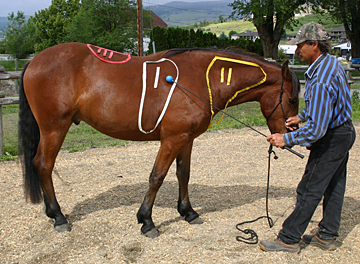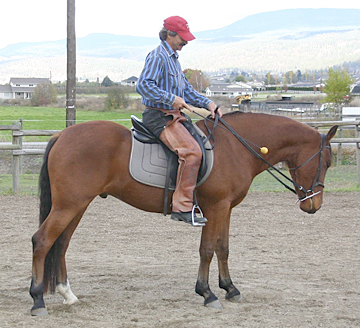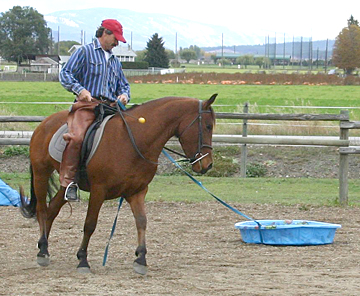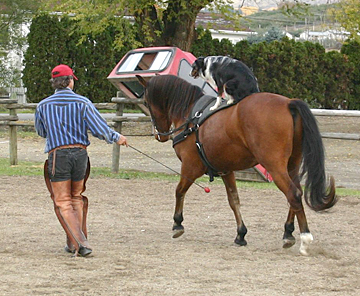by Paul Dufresne
Hope you have made it through all 5 articles on Endotapping. If you have missed parts 1-5, please read them all to get caught up. In the first articles I showed how, by tapping the horse’s body on zones 1 and 2, you could dramatically improve a horse’s emotional state. Later I discussed how the tapping improves the movement by causing the neuron-hormonal release of endorphins and a deeper relaxed state in the horse in-hand from Walk to Canter. Now we will take this to the next natural progression to applying the technique while riding after I share this little story.
I just returned from a teaching a clinic in Saskatchewan where, despite the heavy fog that set in, we still managed to get a very nice group for the demo on Friday night. A trainer with a Natural Horsemanship/Dressage background showed up to see the demo. He could see how the development of the head down cue would be of real use but had difficulty understanding how the tapping would actually improve the emotional state much further than that. At the end of the demo, I explained to him that I had several horses suffering from serious full blown excite cycles that turned into all out flight or bucking and how tapping dramatically changed them - often quite quickly. After returning to his home, this trainer (who had a just such a horse in for re-training) decided, what the heck, and gave endotapping a shot.
I received a phone call from him the night before I was due to leave. He related to me that he had tapped this horse (with his fingers only) and got the most relaxed and softest ride ever with no inclination to buck. He thanked me for sharing in the discussions and that he would be in the next clinic for sure. The point here is that there are not too many techniques with as much forgiveness in its application that still gives such positive results. Even though actual instruction is beneficial, most people can have success and improve their relationship just by doing the best they can after reading these articles.
Pictures will illustrate how to apply this technique to riding better than any description. Once the horse has a positive bend you can tap the horse on either side and get a positive effect. If your horse has a long mane, you may need to tap on the side without mane. Please refer to the photo on the zones again as now we will be concentrating primarily on the zone 2. You can also simulate a bit of tapping with your feet in zone 1 if the horse gets stuck.
I tap the horse before mounting to make sure they are calm. Then I tap them mounted and standing on the spot. Once relaxed with a soft poll I open the rein and send the horse on the circle, keeping one rein shorter and causing just a bit of bend while tapping until the horse relaxes the poll. It’s just that simple but don’t lose patience if you don’t get it right away. If you just keep asking the horse to move on a circle and keep tapping, most horses relax their poll in short order. When you know what you’re doing it could be in 5 seconds to 5 minutes. When you are experimenting, it could take 2-3 times that long. Change the rein and apply on the other side or tap the same side with a changed bend. Straighten the horse before you change rein, leg aid to change the bend the other way, then tap. If the circle is small enough you do this first at a walk and gradually make your circle bigger if the horse stays soft. You then can repeat this with the trot. I always recommend to find the softest jog possible and make sure the horse can maintain its poll relaxed, on the dangle at 90 degrees, before extending gaits.
I would only suggest cantering when you can keep your horse’s poll under control at the walk and trot. The adrenalin surge will kick in and cause an excite/fright cycle unless you have a good cue to relax. If you make sure this is solid in-hand you should find very little difficulty with this riding. When I tap at the canter, I tap on zone 2 in the rhythm of the canter I would like the horse to stay in. If my seat and tapping are together in this, the horse usually relaxes into the effortless canter I want.
Before cantering, you should have calm transitions from walk to trot with few physical aids such as touching the horse with a whip, clucking, slapping your leg, etc. You should also be able to regain the walk easily. Ask your horse to transition from a relaxed long and low jog to a more engaged trot while maintaining a relaxed poll. Through all of this the horse must be balanced and have as much weight on the outside shoulder as the inside. If you don’t have correct balance the canter will not be good. If you need to, please refer to some of my past articles for more info on balancing and softening your horse.
Have the softest, calmest ride you have ever had and remember - if you don’t allow a horse to get anxious you may never have to deal with the headaches that other people might get into. Get the feel good, ask your horse to try something in small steps and always regain the feel good before continuing. A horse that is offered a secure, positive emotional state is usually a reliable partner.
The next installment will show how you can improve performance skills with Endotapping.

Review of Endotapping zones

Endotapping at a stand

Endotapping at a walk, also bomb-proofing by dragging a pool.

Endotapping in-hand at the trot with So-She riding
trainers and clinicians modify techniques to suit their needs, and the needs of their students - both human or equine. This
technique, when combined with shape control and Natural Horsemanship, I have found to be an exceptional
way to lead a horse and facilitate a very healthy partnership.